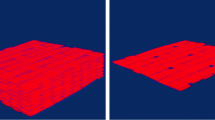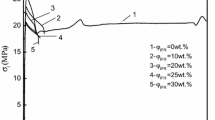Abstract
The authors analyze a mechanism for breakdown of a composite material of the textolite type, composed of the chemical elements H, C, N, and O in an air stream of stagnation enthalpy 14,000–73,000 kJ/kg. A comparison of the theory and the experimental data show that the accuracy of the theoretical model is 25%.
Similar content being viewed by others
Literature cited
B. M. Pankratov, Yu. V. Polezhaev, and A. K. Rud'ko, Interaction of Materials with Gas Flows [in Russian], Mashinostroenie, Moscow (1976).
W. H. Dorrance, Viscous Hypersonic Flow. Theory of Reacting and Hypersonic Boundary Layers, McGraw-Hill, New York (1962).
H. R. Bredtfeldt, “Boundary layer ion density profiles as measured by electrostatic probes,” AIAA J.,5, No. 1, 91–98 (1967).
J. Faye and F. Riddell, “Theory of stagnation point heat transfer in dissociated air,” J. Aero. Sci.,25, No. 2, 73–85 (1958).
V. G. Gromov and N. A. Eremyan, “Investigation of transfer processes in the high-temperature boundary layer on a receding graphite surface,” Izv. Akad. Nauk SSSR, Mekh. Zhidk. Gaza, No. 3, 97–103 (1983).
V. G. Gromov and N. A. Eremyan, “Numerical investigations of heat and mass transfer in the multicomponent chemically nonequilibrium high-temperature boundary layer on the disintegrating surface of charring materials,” in: Heat and Mass Transfer in the Presence of Chemical Reactions. Reports of the VII All-Union Conf. on Heat and Mass Transfer, Minsk [in Russian], Vol. 3, ITMO Akad. Nauk BSSR (1984), pp. 66–72.
B. M. Ovsyannikov, “Breakdown of an axisymmetric body of revolution made of a material of complex chemical compostion in a high-enthalpy air flow,” Izv. Akad. Nauk SSSR, Mekh. Zhidk. Gaza, No. 5, 23–32 (1967).
V. M. Ovsyannikov and G. A. Tirskii, “Breakdown of an axisymmetric body of revolution made of material of complex chemical composition in flow of partially ionized air,” Izv. Akad. Nauk SSSR, Mekh. Zhidk. Gaza, No. 5, 100–110 (1968).
S. L. Madorskii, Thermal Decomposition of Organic Polymers [Russian translation], Mir, Moscow (1967).
Additional information
Translated from Inzhenerno-Fizicheskii Zhurnal, Vol. 50, No. 3, pp. 367—373, March, 1986.
Rights and permissions
About this article
Cite this article
Nikitin, P.V., Ovsyannikov, V.M. & Kholodkov, N.V. Breakdown of an organically based composite material in a high-temperature gas flow. Journal of Engineering Physics 50, 261–266 (1986). https://doi.org/10.1007/BF00870116
Received:
Issue Date:
DOI: https://doi.org/10.1007/BF00870116




